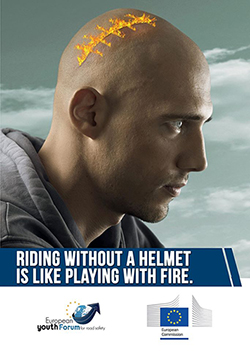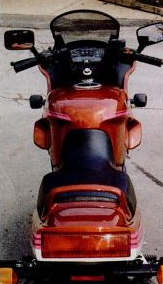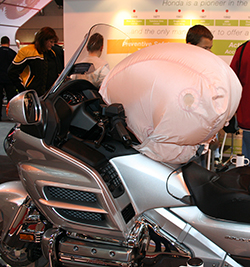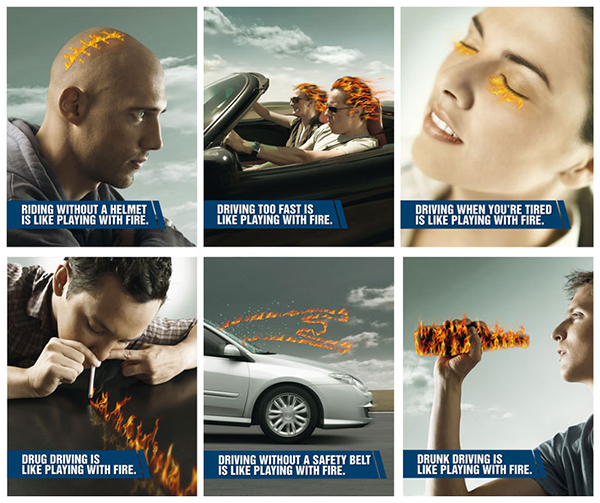 Riding Without A Helmet Is Like Playing With Fire is from a series of “Playing with Fire” posters from the European Youth Forum for Road Safety.
Riding Without A Helmet Is Like Playing With Fire is from a series of “Playing with Fire” posters from the European Youth Forum for Road Safety.
If like us at Right To Ride you are the wrong side of your 21st birthday the European Youth Forum for Road Safety Facebook page is worth checking out, if only to see what is going on in the younger generation as regards road safety.
European Youth Forum for Road Safety on Facebook – Click Here
The European Youth Forum for Road Safety website has a section entitled – Helmets and other safety equipment – which mixes advice for motorcyclists and cyclists.
The advice is: “Whether travelling at high speed on a motorcycle, or meandering along on a bicycle – bikers are vulnerable in a collision.
By taking a number of precautions – such as wearing a helmet or protective clothing – you have a better chance of avoiding serious injury”
There is mention of the wearing of protective clothing and gloves which states that these, “protects against laceration, contamination of injuries and reduces of the severity of bone and muscle injuries.”
The page also says to, “fit leg protectors – these reduce the severity of leg injuries by around 50%.”
We assume that they are talking about fitting “armour” inserts into motorcycle clothing or protectors that are separate from any clothing and can be attached for example via velco think something similar to leg protectors worn by the likes of riot police.
Although it seems apparent that they are not harking back to the nineties and late eighties when leg protectors were developed for fitting onto motorcycles by the Transport and Road Research Laboratory (TRRL), now the Transport Research Laboratory (TRL), we can’t help but recall the uproar at the time and the battles between riders’ organisations and those that wanted to protect us against ourselves.
Helmets and other safety equipment – Click Here
Leg Protectors
 The following is a synopsis of the Leg Protector saga.
The following is a synopsis of the Leg Protector saga.
At the time. Government experts wanted the research on protection for motorcyclists legs to be “speedily” put into effect, that those devices be made compulsory and that research into the use of airbags for motorcycles and into any other device able to improve motorcyclists should be pursued actively.
In 1993 the European Commission in its action programme on road safety stated in the section on active and passive vehicle safety that it proposed to take new initiatives forward which included leg protection devices for mopeds. Mind you they also said that they would also look at devices for preventing increasing speed limits imposed by construction, in particular for two-wheel motor vehicles.
Stepping into the frame in practical terms and up to the plate was the then Roads Minister Peter Bottomley, the Transport Research Laboratory (TRRL) and a Doctor Bryan Chinn, who had previously in 1985 Bryan Chinn presented his PhD thesis “Injuries To Motorcyclists’ Legs: Testing Procedures and Protection”, with the claim that leg protectors would protect riders from serious leg injuries.
The three wise monkeys of motorcycle safety, political will, research and an expert were certainly on a roll, picking up speed to have these mandatory fitted to motorcycles.
Apparently in the UK there were draft leg protection specifications and a series of tests saw a Norton Interpol II used to examine the performance of leg protectors, their effect as regards leg protection on potential leg injuries and that at leg protectors do not increase the risk of injury to other parts of the body. Needless to say all appeared to be well for the advantages for leg protectors.
The research by the TRRL was questioned by the motorcycle industry, IMMA (International Motorcycle Manufacturers Association) and members of the Japan Automobile Research Institute and Dynamic Research, Inc. who commissioned their own studies. The results showed that the leg protector design was only beneficial in 25% of accident situations and actually detrimental in 50% of accidents.
Worse still the effects of the leg protectors on head trajectory and deceleration would lead to increased severe and fatal head injuries. This is caused by the leg protectors restraining the rider and causing pivoting around the hips bringing the head into contact with the car that the motorcycle was in collision with. There was also an increased chance of pelvis fracture, which is potentially fatal. The net result of that design was the lower leg injuries would be transferred to upper leg, torso, and head injuries.
Both rider groups in the UK were against leg protectors but it was the Motorcycle Action Group (MAG UK) who lobbied, ran postcard campaigns, held meetings with Peter Bottomley the Roads Minister and went to the Transport Research Laboratory and cumulate with a Riders Rights Day in Central London attended by over 25,000 riders.
MAG managed to get the interest of prime time TV coverage and Peter Bottomley backpeddled right afterwards by saying that he just thought leg protectors should be fitted by manufacturers as an option.
However the other riders group in the UK the BMF (British Motorcyclists Federation) were involved in their own lobbying and while MAG made the headlines the back story is much more interesting and for that we need to move this tale to North America and the AMA (American Motorcyclist Association).
“International Protection Racket”
 In their 1991 article entitled “International Protection Racket” the AMA posed the question, “Who will design your next motorcycle?” The AMA claimed to have uncovered a bizarre international scheme designed to force sweeping changes in motorcycle design, that would be mandated not through legislation by elected representatives but through litigation by self-styled “experts” in motorcycle safety and they were not far wrong.
In their 1991 article entitled “International Protection Racket” the AMA posed the question, “Who will design your next motorcycle?” The AMA claimed to have uncovered a bizarre international scheme designed to force sweeping changes in motorcycle design, that would be mandated not through legislation by elected representatives but through litigation by self-styled “experts” in motorcycle safety and they were not far wrong.
The AMA say they were tipped off by their connections with the BMF and in 1991 their vice president of government relations, Robert Rasor traveled to England and met John Chatterton-Ross and Stephen Prower of the BMF.
The claim was that Peter Bottomley was pushing his vision of mandatory leg protectors through the back door in America because he was unable to get elected officials to support his position. he was intimidating the motorcycle manufacturers with lawsuits over the issue.
Basically if a motorcycle was not fitted with leg protectors or the optional to have them fitted and a rider was injured in a collision, then they could sue the manufacturer because leg protectors are available.
Somewhere and somehow down the line the whole idea of compulsion faded away and they were derided as causing more harm than they were worth, although leg protectors still surface in discussion in motorcycle design for example in 2001 by RoSPA in their Motorcycle Position paper that the main secondary safety features are leg protectors and airbags.
Looking through all of this there was even an attempt which appeared to suggest that the fitting of air bags would negate any problems caused by leg protectors – and by the “magic” of the internet there is a You tube video on this page of an interview by the then BMFs Jeff Stone (where did he go) with Doctor Chinn which concentrates on air bags and motorcycles.
In 2009 the Federation of European Motorcyclists Federation (FEMA) in its, “A European Agenda for Motorcycle Safety – The Motorcyclists’ Point of View ” stated, “The design of motorcycles has made them increasingly more proficient and specialised and generally reflects a greater emphasis on safety. Because motorcyclists are usually separated from the motorcycle at some time during a crash, protective equipment attached to the motorcycle, e.g. so called “leg protectors” or airbags, is less likely to be effective than protective clothing and should not warrant serious attention.”
So it looks like leg protectors have now been resigned to history or are they?
The European Commission’s – Mobility And Transport – Road Safety webpage states that, “Further research on the relative benefits of leg protectors should be conducted.” albeit written in 2004, leg protectors have left a ghostly impression in motorcycling history.
We hope you enjoyed this small journey into history which took a bit of a turn and twist.
Original Sources – AMA “International Protection Racket” – Click Here – Network – Click Here – MAG Position Statements – pdf – Click Here – MRF Resource Library Click Here
Helmet Wearing
Helmet wearing is mandatory across the EU but the wearing of a helmet is not a European regulation – mandatory helmet wearing legislation is down to individual member states but the standards for what you wear is through ECE 22-05 a European Standard or equivalent standard.
For example in the UK:
You must wear a safety helmet when riding a motorcycle on the road. All helmets sold in the UK must comply with at least 1 of these:
- British Standard BS 6658:1985 and carry the BSI (British Standards Institution) Kitemark
- UNECE Regulation 22.05
- any standard accepted by a member of the European Economic Area which offers a level of safety and protection equivalent to BS 6658:1985 and carry a mark equivalent to the BSI Kitemark
Original Source – Click Here
In the UK the Safety Helmet Assessment and Rating Programme helps riders to make a more informed choice when choosing a helmet.
SHARP came into being in 2007, after the Department for Transport found real differences in the safety performance of motorcycle helmets available in the UK.
Original Source – sharp.direct.gov.uk
Further Links & Information
“Playing with Fire” posters from the European Youth Forum for Road Safety
TRL Infamous For Smashing Bikes And Dummies Into Things




Speak Your Mind